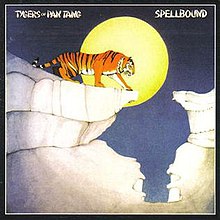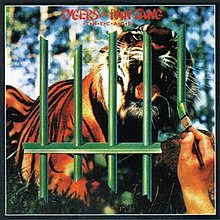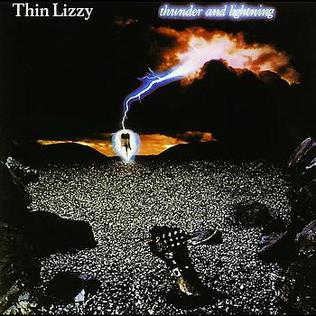
Having already tackled such features as solo artists, beginner's guides and full histories of bands and artistes, this is a new section I've been working on for some time now. I had many titles for it, but none seemed to fit, to encompass the ethos of what this section would be all about. Then recently I had cause to feature a song in the section “More than words” which made me think. That song was by Kevin Johnson, and is called “Rock and roll I gave you the best years of my life”. Though Johnson's song is about his failure to make it in the music biz, and those centred on in this section all most certainly have been successful in that business, the title just fit and I knew this was what I was going to call the feature.
So what's it about? Well, basically it's going to be a (probably quite occasional, due to the amount of work it will need) look at a particular artist, following their entire music career, from beginning to either end, or the present if they are still recording and gigging. If they've been in more than one band, I'll cover that. If they've done solo work, that'll be examined. Any collaborations with other bands or artistes, whether as a one-off or as part of that band, or as a team-up, will also come under the microscope, as will any live gigs they've taken part in, that have been committed to disc.
In short, I'm going to try to trace the path of the artist, from his or her musical beginnings, as far back as YouTube will allow, to where they are now. I'll be looking at how, if at all, they influenced the various bands they either started or joined, and indeed how those bands changed, if at all, after they left. A whole life in music, insofar as I can.
(Note: as in most of my larger features, this will be divided into two parts, primarily because of the restriction on the amount of images allowed, but also, in this case, to serve as a dividing line between the two sides of the artist's career, as you will see below.)
The first to step into the spotlight is that well-known stalwart of such bands as Thin Lizzy, Tygers of Pan-Tang and Whitesnake among others, almost as famous for his perm as for his fretwork, the one, the only,
 Part I: Workin' for the Man
Part I: Workin' for the Man
John James Sykes was born on July 25 1959 in Reading, and although his first band was Streetfighter, and he was later in John Sloman's Badlands, there appears to be no footage on YT of the former (not to mention how hard it is to avoid videos for the popular videogame!) and the latter keep getting confused with another band who also go by the name of Badlands. I don't know the music of either, so rather than end up putting up incorrect videos, or indeed referring to the wrong bands, I won't feature anything from either band here. It further appears that John Sloman's Badlands only ever recorded a demo tape, not any albums, so not surprising then that there exists no footage of them.
In a very real sense, then, Sykes' career began in earnest when he joined heavy metallers Tygers of Pan-Tang, although he got together with them only for their second album, after the far heavier and much more raw “Wild cat” (see my review many pages back) had come and gone. By 1981, the Tygers were being pushed by their label into a much more commercial, AOR direction, and John played guitar on what would be their last truly rock album, 1981's “Spellbound” (still far inferior to the rockin' “Wild cat”) and then on their follow-up to that, 1982's “Crazy nights”. Both albums are generally seen by Tygers fans as being indicative of the watering-down of the band, and after 1983's release, “The cage”, the Tygers effectively broke up, although they did reform later, but never regained the popularity they had had at the height of the eighties.

Sykes joined the Tygers after Jess Cox, lead singer on the debut, left the band in an acrimonious split, and he was drafted in to supplement founder member and guitarist Robb Weir, adding an extra dimension to the guitar parts on the album. “Tyger Bay” (below) is a good example of how he stamped his own identity on the Tygers' sound.

And the rather good “Running out of time” from “Crazy nights” has him in fine form.

John was then approached by the aforemenioned John Sloman, and asked to join his new band, John Sloman's Badlands, but although they cut a demo tape they did not stay together and broke up very quickly. He officially remained with the Tygers after the disintegration of Badlands, but he only contributed to two tracks on what would be their penultimate recording, actually my favourite of theirs after “Wild cat”, “The cage”. This is one of them, unfortunately not the one I wanted to feature, damn you, YouTube! It's the infinitely inferior cover, “Love potion no. 9”, but hey, Sykes is on fire on it!
The rest of the Tygers were reportedly annoyed at Sykes for “abandoning” them during the recording of “The cage”, as he went to audition for Ozzy Osbourne, in the sad light of the untimely death of Randy Rhoads in 1983. It was however a gig he did not succeed in winning, but his time away from the band meant that he was only able to play on two of the tracks that appeared on “The cage”, as mentioned.

After he parted company with the Tygers, John was approached by Phil Lynott, and joined Thin Lizzy as a replacement for Snowy White. He featured on the last studio album by the band, Phil Lynott's swansong, “Thunder and lightning”, on which he not only played guitar but also co-wrote the biggest hit single taken from that album, “Cold sweat”.

Sykes became a real favourite with Lizzy fans during the short time he was with them, from late 1982 to autumn 1983, when he toured with them on their final tour before they broke up, and he appears on the live album “Life/Live”, recorded during that tour. This also gave him the unmissable chance to play onstage with ex-Lizzy legends Gary Moore, Eric Bell and Brian Robertson. It seems not too much footage of the tour made it to YT, but here's Sykes at his best on “The sun goes down”, from the gig in the Regal Theatre.
After Lizzy broke up, John joined Brian Downey, Scott Gorham and Darren Wharton on Phil Lynott's solo tour of Europe, under the banner of “The Three Musketeers” (even though, including Sykes, there were five of them!) and after this ended, John Sykes, never a man to stand still for long, took up David Coverdale's offer to join Whitesnake, and although his first album with them, 1983's “Slide it in”, had original guitar on it by Micky Moody, when he left the band due to irreconcilable differences between he and Coverdale, Sykes was afforded the opportunity to redo the guitar tracks when the album was remixed and reissued for its US release.
Moderator cut: image removed
Sykes then toured with Whitesnake, cutting another album with them, 1987's self-titled, seen as the “rebirth” of the band after Coverdale's ego had led to his firing Cozy Powell, Colin Hodgkinson and Mel Galley, with Jon Lord having left to rejoin his old band Deep Purple. Neil Murray had come back, having left the band after 1981's “Saints and sinners”, and a new drummer and some “guest” keyboard players recorded the new album, which was spectacularly successful, due in no small part to Sykes' contribution, both on guitar and songwriting, of which he collaborated on the vast majority with Coverdale.

But there are few things as overbearingly huge, it would appear, as David Coverdale's ego, and once again he decided to dispense with everyone in the band, going on to record their next album, 1989's “Slip of the tongue”, with a whole new crew. Perhaps burned by his treatment at Coverdale's hands, and wanting to have his destiny in his own hands, Sykes decided it was time to form his own band.